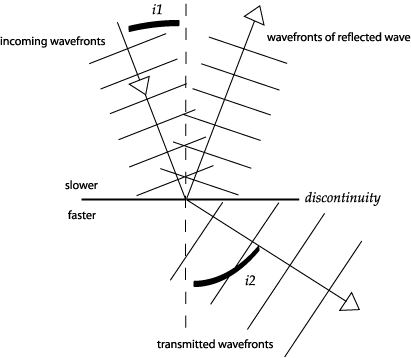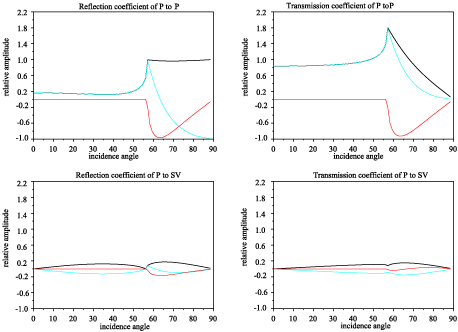
Step 2: Reflection and Transmission coefficients.
When seismic waves encouter a sudden change in material properties (a discontinuity), part of the energy will be transmitted and the rest of the energy will be reflected by the discontinuity. It is relatively simple to derive how large the transmitted and reflected amplitudes will be if the incoming wave is a plane wave. At a discontinuity the wavefield has to satisfy two boundary conditions, 1) the displacement has to be continuous, and 2) the components of stress that act on the boundary also have to be continuous. These two conditions lead to expressions that relate the amplitudes of the reflected and transmitted wave to the amplitude of the incoming wave. In your textbook it is show how to determine these expressions for an SH wave (on pp. 97-100).
The amplitudes of the reflected and transmitted waves depend on

Figure 1 A plane wave goes from a slow medium to a faster medium, part of the energy is reflected back into the first medium, part of the energy is transmitted into the faster medium. The wavefronts are further apart in the fast medium.
Copy file Y:\Intro_seismology2002\scripts\discontinuity.sci to your own folder Z:\yourname. Start Scilab and change directories by typing: chdir('Z:\yourname'); Run the script discontinuity.sci by typing: exec "discontinuity.sci"; It will ask you for the parameters of two media and will calculate the amplitude of the reflected and transmitted waves assuming that the angle of incidence is 0 (normal incidence, meaning that the rays are perpendicular to the discontinuity). In that case, there are no conversions from P to S or S to P.
Run the script several times to answer the following questions (with every answer, provide the values that you used as input to the script):
1. Choose the velocities and densities so that only the P velocity increases (by 10%) across the dicontinuity.
What are the amplitudes of the transmitted and reflected waves?
2. Choose the velocities and densities so that only the S velocity increases (by 10%) across the discontinuity.
What are the amplitudes of the transmitted and reflected waves?
3. Choose the velocities and densities so that only the density increases (by 10%) across the discontinuity.
What are the amplitudes of the transmitted and reflected waves?
(4.) Choose the velocities and densities so that only the product of S velocity and density increases (by 10%)
across the discontinuity.
What are the amplitudes of the transmitted and reflected waves?
5. Does it matter exactly which values you choose in 1,2,3, and 4?
From your answers to questions 1 through 4, you should be able to conclude that when the incidence is normal to the discontinuity, the relative impedance (=density times velocity) contrast controls the amplitudes of the transmitted and reflected waves.
However, another factor that is important is the incidence angle. In Figure 2, amplitudes of reflected and transmitted P and SV waves (an SV wave is an S-wave with its particle motion contained in the plane connecting source and receiver) generated when a plane P wave impinges on the Moho, the discontinuity between crust and mantle, are shown. The values were calculated for the PREM model. On page 104 of your textbook a similar picture is shown for SH waves (S waves with their particle motion in the plane perpendicular to the plane containing source and receiver).

Figure 2 A plane wave goes from the slower crust to the faster (and denser) mantle. Shown are the amplitudes (thick line) of the reflected and transmitted waves. Also show are the imaginary (red) and real (blue) parts of the reflection/transmission coefficients.
Answer the following questions:
6. In reflection seismology (when they set off explosives and record the wavefield that is reflected by
subsurface layers), people often assume that the rays are normal to the layering. Explain why this may still
give a good estimation of the impedance contrast as a function of depth, even though the rays have incidence angles
larger than 0?
7. Something funny is going on for rays with incidence angles larger than about 60 degrees. The reflection and transmission coefficients
are getting an imaginary component and the amplitude of the transmitted wave is larger than 1. What is going on?
(Read section 6.3.3 of your textbook.)
8. The amplitudes of the reflected and transmitted waves add up to a
number larger than 1. Does this mean that energy is not conserved? (Read
section 6.3.2. of your textbook)
9. Also, when a plane wave moves from a high velocity region to a low velocity region, the amplitude of the transmitted wave (of the same type, i.e., P or S) is larger than the amplitude of the incident wave. Why is this the case? (Read section 6.1 of your textbook)